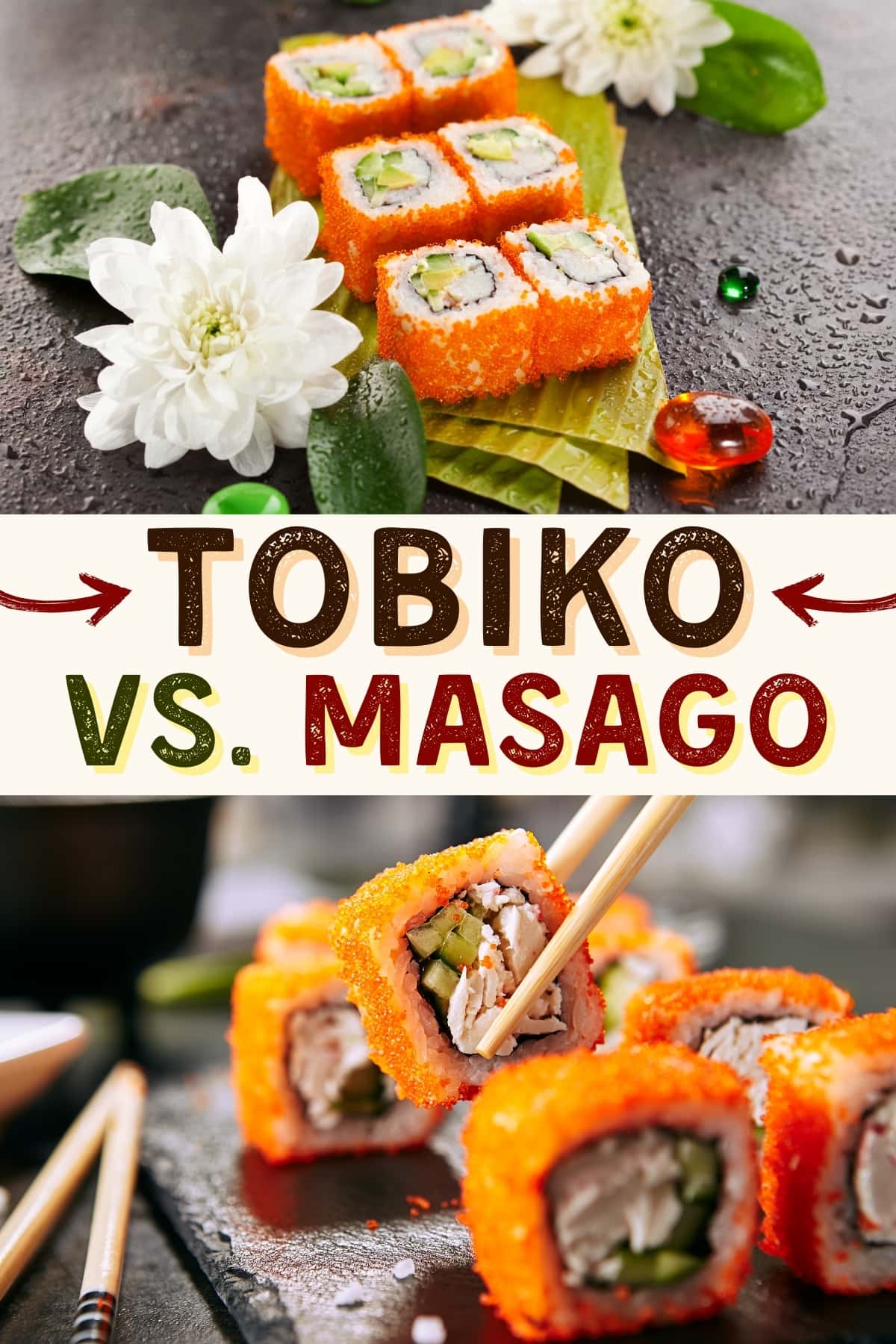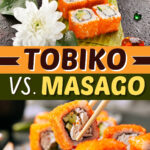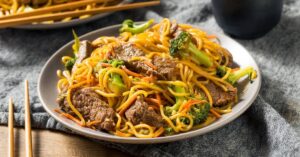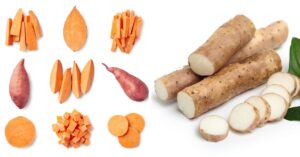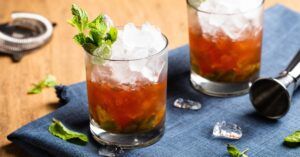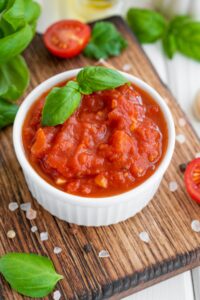In the world of sushi and seafood, there’s some confusion over tobiko vs. masago. Both are delightful, delicate, and bursting with flavors.
Both are types of fish eggs used to garnish sushi. However, they come from different fish. They exhibit distinct characteristics in flavor, color, texture, and culinary applications.
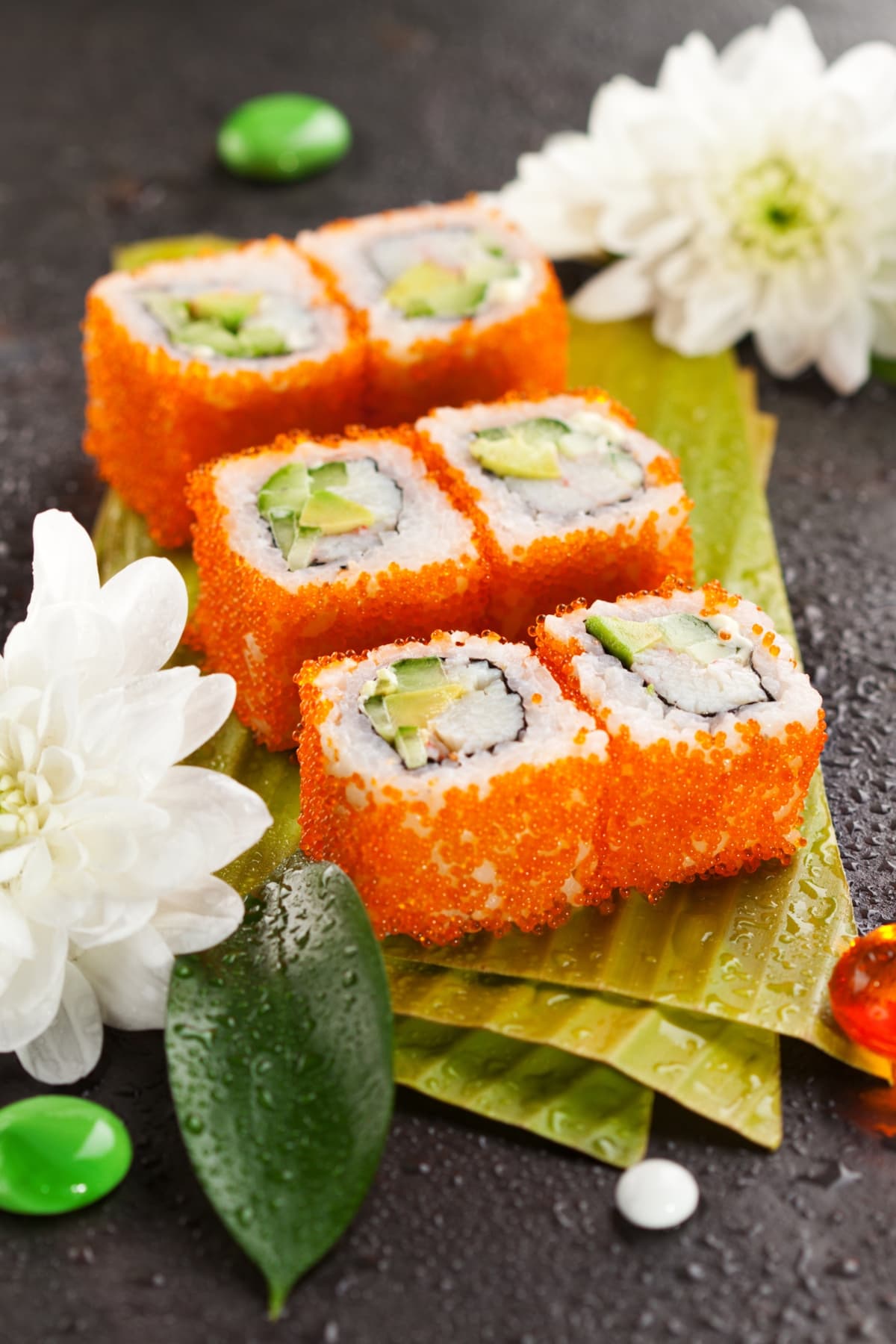
They’re petite yet pivotal sushi ingredients. But many people don’t clearly understand the differences between them.
We’ll examine what tobiko and masago are, how they’re different, and more.
Tobiko vs. Masago (What’s the Difference?)
Both ingredients frequently appear on sushi bars. However, tobiko and masago are different. Let’s take a closer look at what sets them apart.
Appearance
One of the easiest ways to tell these ingredients apart is to look at them. Tobiko is larger than masago, and their colors are entirely different.
Tobiko’s natural color is burnished gold or orange. However, sellers frequently use artificial dyes to turn the eggs into vibrant colors.
Some sellers artificially color masago, as well.
However, it’s much paler than tobiko, even when dyed. Naturally, its color is light yellow. When dyed, it rarely reaches the vibrant shades of tobiko.
Both look shiny and somewhat translucent.
Fish Species
Tobiko are eggs from flying fish native to the Atlantic and Pacific Oceans.
On the other hand, masago comes from a species of smelt fish called the capelin fish. It also comes from the Atlantic and Pacific Oceans but is found only in the northern areas of each.
Taste & Texture
Tobiko’s texture is similar to caviar in that the eggs pop when you bite them. They’re also slightly crunchy. By contrast, masago eggs are softer, smoother, and have no signature pop.
Both ingredients are salty and feature the typical “ocean brine” taste. However, masago’s flavor is more delicate and less salty than tobiko.
Price
Of the two options, tobiko is the more expensive. However, both are reasonably priced in most cases.
Still, masago is cheaper. That’s the reason some sellers dye their masago eggs. They hope that by dying them, they’ll look more like tobiko.
And if people think they’re purchasing tobiko, they might be willing to pay slightly more for it. You can easily check out the label to ensure you aren’t getting duped.
Culinary Uses
Masago and tobiko both share many of the same culinary uses. People primarily use both to garnish their sushi or sashimi.
The brightly colored, shiny eggs add visual appeal, texture, and flavor. You can also use them in other seafood dishes or even in salads.
If you choose between them, consider what texture and flavor you want. If you want that nice pop when you bite into your sushi, opt for tobiko.
If you prefer a milder, less salty garnish, masago is the better choice.
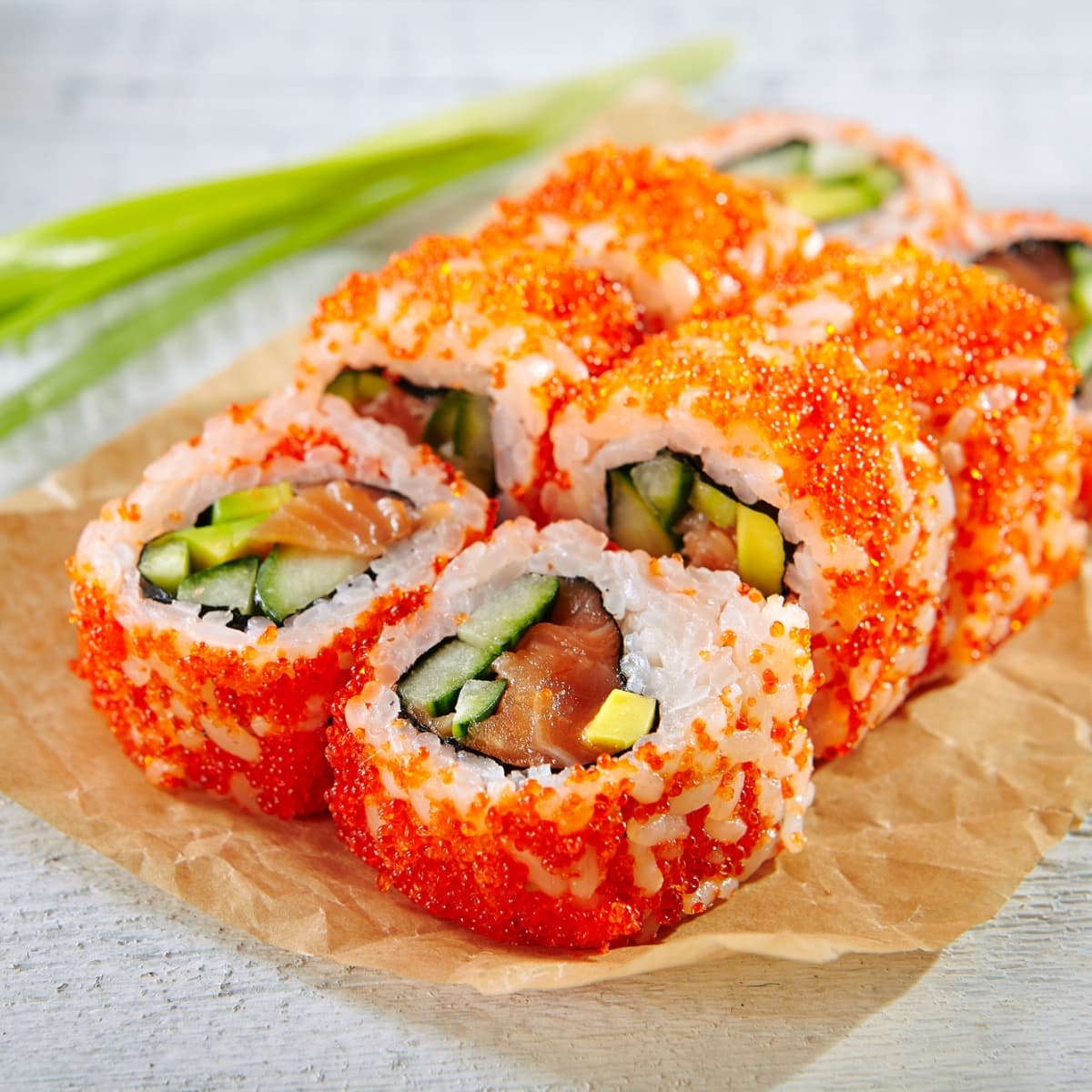
What Is Tobiko?
Tobiko, from the Japanese word tobiuo no ko, are the eggs, or roe, of flying fish. There are many varieties, namely distinguished by their colors.
All varieties have a crunchy, caviar-like texture and a salty, umami taste. Typically, tobiko has a gold or orange color. However, sellers use other ingredients to dye it.
People typically add tobiko to sushi rolls or other seafood dishes. They sometimes serve them by themselves on a bed of rice, as well.
Types of Tobiko
Here are some of the most common types of tobiko.
Golden Tobiko
Golden tobiko refers more to the quality than the color of the tobiko. (Although its color is also somewhere between yellow gold and orange.)
Still, golden tobiko comes from the highest quality flying fish. It’s the most superior form of tobiko and is untouched by dyes.
Orange Tobiko
Orange tobiko is the most commonly sold variety of tobiko. It’s also the variety we typically see here in the United States.
Orange tobiko may or may not contain ingredients to enhance its color.
Tobiko’s natural color is orange already. However, some sellers infuse the eggs with citrus juices and dyes for a brighter color and zestier flavor.
Black Tobiko
Sellers use squid ink to transform naturally light tobiko into black tobiko. The ink also gives the eggs a more umami-packed, slightly bitter flavor.
Some people claim they taste a nuttiness to it, as well.
Red Tobiko
Most red tobiko is dyed with beets, giving it an earthy flavor. However, some sellers use chiles to dye the eggs red.
In that case, they’re spicy with distinctly peppery notes.
Yellow Tobiko
Yellow tobiko is flavored with lemons, yuzu, and other citrus fruits. The fruits give the yellow tobiko a bright, light, citrusy flavor. However, they don’t contribute to its yellow color.
That comes totally from an artificial yellow dye.
Green Tobiko
Artificial dye is also what gives green tobiko its signature green color. However, the green represents wasabi, which sellers add to these green eggs.
As a result, the eggs are much spicier than any other color of tobiko.
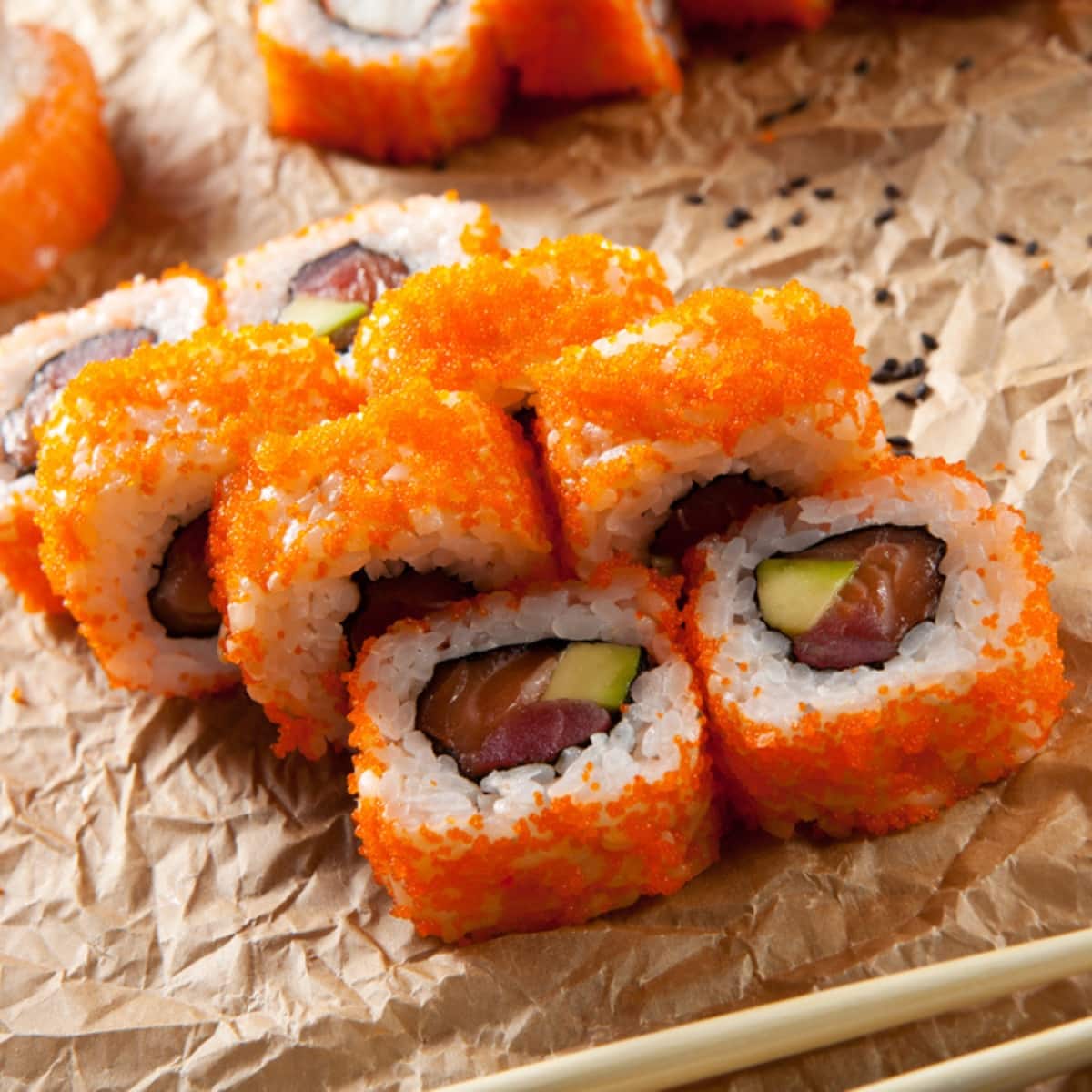
What Is Masago?
Masago is the roe (eggs) from smelt fish, primarily the capelin smelt. Some also come from the Pacific Ocean’s shishamo smelt.
They’re smaller, softer, and less crunchy than tobiko. However, people use them for the same basic purposes: as sushi or sashimi garnishes.
They also have a milder, less salty, and more delicate flavor than tobiko.
Types of Masago
Originally, masago are a pale yellow color. Their hue is nowhere near as bright as tobiko’s natural color. However, sellers often color masago to make the eggs brighter and prettier.
Here are the most common colors of masago.
Orange Masago
Orange masago takes its color from artificial food dye. Sellers also flavor it with other ingredients like MSG, corn syrup, and soy sauce.
It has a salty, mildly sweet flavor with only light hints of umami.
Black Masago
Black masago contains the same ingredients as orange masago. (Masago, salt, MSG, corn syrup, and soy sauce.) Therefore, it tastes the same as orange masago.
The only difference is that black masago is dyed with black food dye. It doesn’t change the flavor, though.
Red Masago
Again, red masago tastes just like black and orange masago. Its ingredients are the same, but the food coloring for this one is red.
Wasabi Masago
Wasabi masago is the only variety that tastes different from the others. It, too, contains the same essential ingredients. However, sellers infuse it with horseradish or wasabi for extra heat.
The green color comes strictly from food dye, though.

Where to Buy Masago and Tobiko
You can easily purchase masago and tobiko online. Amazon carries them, as do many online retailers.
You can also find them at specialty stores, Asian markets, and mass merchandisers.
Both Walmart and Target have carried them occasionally. Whole Foods keeps them in stock regularly.
Both are relatively reasonably priced, but some brands are more expensive.
You can also find umami-flavored vegan varieties. They look and feel the same but are 100% animal cruelty-free.
